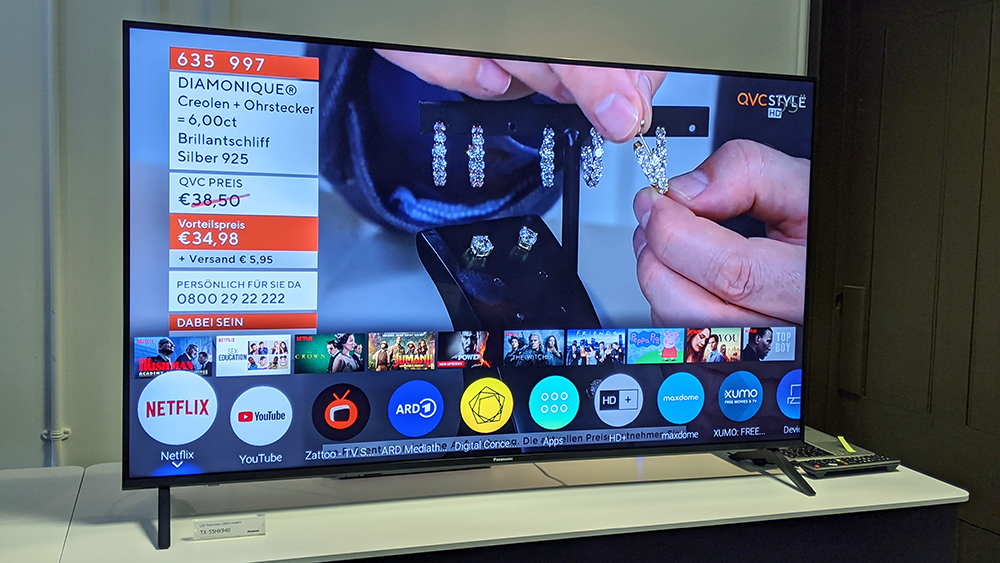Panasonic 2020 TV lineup: everything you need to know
The A-Z on Panasonic's eight OLED and 13 LCD TVs for 2020

It's a big year for Panasonic, what with it being a worldwide partner of the Tokyo 2020 Olympic and Paralympic Games. And the Japanese giant's TV division has started it confidently by unveiling its flagship HZ2000 OLED at CES 2020 and the rest of its 4K OLED and LCD line-up at its more recent European event.
The newcomers have big shoes to fill. Every 2019 Panasonic TV we reviewed, we were impressed by – and we even called the top-tier GZ2000 OLED "the TV by which all others can be measured".
That bodes well for Panasonic's new generation of TVs, especially as, naturally, the company has evolved them over last year's models with improvements in picture, sound and features.
So what's new for Panasonic 2020 TVs? Allow us to run down the specs, features and differences for all the models...
Panasonic OLED TVs: HZ2000, HZ1500, HZ1000
Panasonic first announced three OLED TV ranges to succeed the four from last year. The HZ2000, HZ1500 and HZ1000 series each come in 55in and 65in sizes and share a lot in common. It has more recently expanded that line-up with the more affordable, entry-level HZ980 series, which boasts most of the technology of its siblings but goes without the top-tier motion smoothing technology and swivel stand.
Like the 2019 OLEDs, every 2020 OLED (and LCD, for that matter) boasts support for HDR10+, Dolby Vision and Dolby Atmos. This year's OLEDs also support the two big headline TV features introduced at CES in January – Dolby Vision IQ and Filmmaker Mode too.
Dolby Vision IQ works to optimise Dolby Vision content on your TV according to the brightness of the room, while Filmmaker Mode overrides the TV's processing (such as motion smoothing and detail enhancement) to allow content to be displayed at the aspect ratio, colour and frame rate intended by the content’s creator.
The latest hi-fi, home cinema and tech news, reviews, buying advice and deals, direct to your inbox.
While LG has also pledged support for the two technologies, Panasonic has implemented its own unique application of Filmmaker Mode by adding ‘Intelligent Sensing’, which dynamically adjusts HDR10+, HDR10, HLG or SDR pictures based on the lighting in your room. Panasonic is keen to point out that it doesn't just adjust the luminance, it 'intelligently' compensates saturation, optimises the gamma in the brightest areas and adds luminance.
Essentially, both aim to adjust picture performance according to the lighting conditions of your room so that, for example, dark scenes don't look too dark in brightly lit environments.
As far as support for industry modes goes, Panasonic is also hoping to enable a firmware update for Netflix Calibration later in the year.

The 2020 OLEDs sport a next-gen processor and next-gen, LG-sourced panel, as is expected. The HZ2000 differentiates itself from its siblings with Panasonic’s superior custom-made Master HDR OLED Professional Edition panel, which promises 20 per cent higher average and peak brightness capabilities over the panel found in the HZ1500 and HZ1000. It has a more advanced processor, the HCX Pro Intelligent, than the two ranges below it, too.
Fittingly in time for the Tokyo Olympics 2020, motion handling has been improved on this year’s OLEDs thanks to a more complex implementation of black frame insertion. While typically OLED TVs using this technique insert a black frame in between each frame of moving content, the new Panasonic OLEDs dynamically adjust the duration of the black frame to find a ‘sweet spot’ to ultimately, Panasonic says, enhance smoothness while reducing the flicker effect.
Panasonic has been more generous in the sound department this year too. Whereas the GZ2000 was the only range of last year’s to boast built-in upward-firing drivers for effectively delivering Dolby Atmos soundtracks, this year that benefit extends further down the line to the HZ1500.
The HZ2000 boasts Panasonic’s Tuned by Technics, 360-degree Soundscape Pro audio system, which can output 140 watts of power, while the HZ1500’s 360-degree Soundscape (without Technics' tuning) arrangement outputs 80 watts. The HZ1000 settles for front-firing speakers, yet still supports Atmos.
And lastly, Panasonic is bringing back the swivel stand! The HZ1500 and HZ1000 OLEDs feature a swivel pedestal, allowing viewers to angle the screen freely towards their viewing position.
Our first impressions of Panasonic's 2020 OLED TVs are very positive indeed. In our review of the 55in HZ1500 (TX-55HZ1000B), we called it "a brilliant, premium TV... this is undeniably one of the very best TVs you can currently buy. If you’re in the market for a premium OLED, you really have to check it out". High praise, then.
Panasonic 2020 OLED TV specs
Panasonic HZ2000
65in HZ2000 £4299
55in HZ2000 £3299
Professional Edition 4K OLED panel
HCX Pro Intelligent Processor
Smooth Motion Drive Pro
360-degree Soundscape Pro system with upward-firing speakers (140 watts)
Dolby Atmos
HDR10+, Dolby Vision, HLG, HLG Photo, HDR10
Dolby Vision IQ
Filmmaker Mode with Panasonic's Intelligent Sensing
Amazon Alexa / Google Assistant voice control
HDMI 2.1 ports
My Home Screen 5.0
Panasonic HZ1500
65in HZ1500 £2999
55in HZ1500 £2399
4K OLED panel
HCX Pro Intelligent Processor
Smooth Motion Drive Pro
360-degree Soundscape system with upward-firing speakers (80 watts)
Dolby Vision
HDR10+, Dolby Vision, HLG, HLG Photo, HDR10
Dolby Vision IQ
Filmmaker Mode with Panasonic's Intelligent Sensing
Amazon Alexa / Google Assistant voice control
HDMI 2.1 ports
My Home Screen 5.0
Swivel stand
Panasonic HZ1000
65in HZ1000 £2699
55in HZ1000 £1899
4K OLED panel
HCX Pro Intelligent Processor
Smooth Motion Drive Pro
Dolby Atmos
HDR10+, Dolby Vision, HLG, HLG Photo, HDR10
Dolby Vision IQ
Filmmaker Mode with Panasonic's Intelligent Sensing
Amazon Alexa / Google Assistant voice control
HDMI 2.1 ports
My Home Screen 5.0
Swivel stand
Panasonic HZ980
65in HZ980
55in HZ980 £1799
4K OLED panel
HCX Pro Intelligent Processor
Dolby Atmos
HDR10+, Dolby Vision, HLG, HLG Photo, HDR10
Dolby Vision IQ
Filmmaker Mode with Panasonic's Intelligent Sensing
Amazon Alexa / Google Assistant voice control
HDMI 2.1 ports
My Home Screen 5.0
Panasonic LCD TVs: HX940, HX900, HX800

OLEDs may have sat pretty at the top of Panasonic's line-ups for some years now, but its 2020 TV line-up wouldn’t be complete without LCD TVs. There are three new 4K LCD ranges this year – 13 models spanning 40in and 75in screen sizes.
The HX940 (43in, 49in, 55in, 65in and 75in), HX900 (43in, 49in, 55in and 65in) and HX800 (40in, 50in, 58in and 65in) all support Dolby Atmos, as well as an impressive roster of HDR formats: Dolby Vision, HDR10+, HDR10, HLG and HLG Photo. The HX900 adds to that HDR Cinema Display, which offers increased brightness, while the H940 supports the more advanced HDR Cinema Display Pro.
Representing the company’s pinnacle LCD performance, the HX940 also boasts a faster (100Hz) screen refresh rate, as well as the HCX Pro Intelligent processor (as opposed to a HCX one in the HX800 and HX900).
Panasonic’s Local Dimming Intelligent Pro is also onboard to improve contrast by adjusting the backlight and LCD shutters themselves – essentially mimicking the operation of thousands of virtual local dimming zones.
Last but not least, the HX940 and HX900 feature Panasonic’s two-way stands that allow owners to position the two pedestal feet in either a central position, or on the edge of the TV so that it can be easily placed on either a wide or narrow tabletop.
Our first experience of Panasonic's 2020 LCD line-up comes courtesy of the TX-58HX800B – and it's even better than last year’s What Hi-Fi? Award-winner (the TX-58GX800B) thanks to its excellent contrast handling, rich, balanced colours and solid motion processing.
4K LCD
Panasonic HX940
43in HX940
49in HX940
55in HX940
65in HX940 £1699
75in HX940 £2499
HCX Pro Intelligent processor
100Hz refresh rate
Local Dimming Intelligent Pro
Dolby Vision, HDR10+, HDR10 HLG, HLG Photo, HDR Cinema Display Pro
Dolby Atmos
Amazon Alexa / Google Assistant
My Home Screen 5.0
Panasonic HX900
43in HX900
49in HX900
55in HX900
65in HX900
HCX Pro Intelligent processor
Dolby Vision, HDR10+, HDR10 HLG, HLG Photo, HDR Cinema Display
Dolby Atmos
Amazon Alexa / Google Assistant
My Home Screen 5.0
Panasonic HX800
40in HX800 £699
50in HX800 £799
58in HX800 £999
65in HX800 £1399
HCX processor
Dolby Vision, HDR10+, HDR10, HLG, HLG Photo
Dolby Atmos
Amazon Alexa / Google Assistant
My Home Screen 5.0
Panasonic My Home Screen 5.0 OS

Every OLED and LCD TV will sport the latest version of Panasonic's smart TV OS. My Home Screen 5.0 brings some small usability improvements to the table. For example, when the owner hovers over the icon of a supported streaming service (such as Netflix and YouTube) recommended titles will pop up in a bar above it for easier access to popular shows.
The TVs also support the HbbTV Operator App (except in UK). In 2019 Panasonic TVs announced world’s first support for HD+ and expanded support to M7 via a firmware update. In 2020, Panasonic will continue to support both HD+ and M7.
The free, global XUMO streaming service, which delivers both over-the-air and over-the-top channels, also comes to this year's models.
Finally, Google Assistant and Amazon Alexa support is across the board, allowing users to operate some TV functions – like app launching – simply by using their voice.
Panasonic Pro features
Panasonic's 'Hollywood to your Home' tagline for its OLEDs is rooted in the fact they are used in many studios and post-production houses in Hollywood and throughout the world. And because of that it not only wants to satisfy consumers like you and I but also working industry professionals who are using the TVs to help them, for example, grade colour for films. To that end, the 2020 OLED TVs Panasonic have two new features, supposedly requested from the post-production community in Hollywood and beyond.
Firstly, tone-mapping – essentially how the TV handles HDR highlights that are too bright for it to display – can now be turned off in the menus, giving professionals more scope to work on the source content right the way up until it hits the native brightness of the panel, as opposed to the level the TV would normally 'clip' it at.
And secondly, Panasonic has introduced the “world’s lowest” calibration points at 1.3 percent and 0.5 percent, so that professionals and enthusiasts alike can achieve a more nuanced transition from pitch-black to just above black.
MORE:
Best Panasonic TVs: OLED, HDR, 4K, budget, premium
Samsung 2020 TV lineup: everything you need to know
Sony 2020 TV lineup: 4K, 8K, OLED, everything you need to know

Becky is a hi-fi, AV and technology journalist, formerly the Managing Editor at What Hi-Fi? and Editor of Australian Hi-Fi and Audio Esoterica magazines. With over twelve years of journalism experience in the hi-fi industry, she has reviewed all manner of audio gear, from budget amplifiers to high-end speakers, and particularly specialises in headphones and head-fi devices.
In her spare time, Becky can often be found running, watching Liverpool FC and horror movies, and hunting for gluten-free cake.
